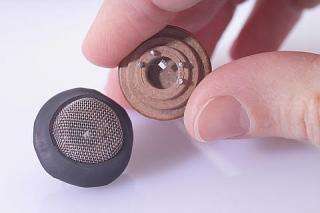Russian capabilities benefit the hydrogen economy

The Department of Energy's Pacific Northwest National Laboratory has brokered a cooperative partnership between a U.S. firm, a Russian Institute and its scientists for commercialization of a miniature hydrogen gas sensor with improved reliability and response time. Such a device will provide added safety, detection capability and efficiency to a variety of applications industry-wide.
The collaboration represents the latest commercial venture between technical institutes in the former Soviet Union, DOE national laboratories and U.S. industry under the DOE’s National Nuclear Security Administration's Global Initiatives for Proliferation Prevention program. GIPP is a nonproliferation program that helps to redirect former weapons of mass destruction scientists to sustainable, non-military employment in countries where scientists and technicians are at risk of recruitment by terrorists or rogue states.
In May 2006, Battelle exclusively licensed patent applications based on certain inventions derived under a Cooperative Research and Development Agreement, or CRADA, to Apollo, Inc. of Kennewick, Wash. Battelle operates PNNL for the Department of Energy and transfers technologies to the marketplace through licenses and other means. The new approach to the sensor technology was created by scientists at the Karpov Institute of Physical Chemistry in Moscow, Russia. The institute retains invention ownership rights within the former Soviet bloc countries.
The Russian scientists, professors Leonid Trakhtenberg, Genrikh Gerasimov, and Vladimir Gromov, were utilizing nanoscale materials for sensing reactive gases. NNSA’s GIPP program provided the transfer mechanism to convert their nanoscale approach into commercially available products and introduce it to the market place. The program also allowed for improvement and optimization for a range of commercial gas sensor applications, including uses in mine safety, the hydrogen fuel economy, and oil refining.
“The Global Initiatives for Proliferation Prevention program opened an important door to this technology, which may provide safer working conditions for an entire industry,” says Ron Nesse, PNNL GIPP program manager. “For example, a dangerous hydrogen gas safety hazard can result during the high-pressure refining of crude oil with high sulfur content. This improved gas sensing technology is now ready to be applied toward making the production and storage of hydrogen safer,” says Nesse.
Apollo Sensor Technology, a division of Apollo, Inc., is commercializing the technology. AST Vice President for Business Development, Dan Briscoe, says industry is looking for the next level of leak detection technology. Briscoe noted that industry representatives have expressed a desire for a good, cost-effective hydrogen sensor with a quick response time. “To realize the benefits of the emerging hydrogen economy,” he says, “the industry requires a small sensor that will operate reliably for a long period of time.” AST anticipates marketing the sensors to industries that manufacture, store and use hydrogen in their production process.
Briscoe added that the same approach is capable of detecting and measuring other gases as well, including ammonia, methane and carbon monoxide. Research is currently underway to refine those capabilities.
The collaboration between the Russians, PNNL and Apollo started about five years ago according to Brian Opitz, PNNL GIPP nanometals sensor project manager. “In 2002, PNNL began searching for a U.S. business partner to commercialize the technology, and approached Apollo,” Opitz says. “Two years later, a CRADA was signed to develop, test and produce sensors that would detect and measure various gases.” This past September, a patent was filed on the gas sensor approach.
“AST will pay Battelle royalties derived from sales of the technology. Under the provisions of the GIPP Program, Battelle will then share such royalties with the Russian institutes,” Opitz explained. The GIPP program is structured to fund projects that engage former Soviet weapon scientists to help prevent the proliferation of weapons expertise. In addition to supporting applied research projects to engage displaced Russian scientists, commercially successful projects lead to private-sector income and employment for those scientists, while also benefiting U.S. industry with new sources of technology.
Source: DOE/Pacific Northwest National Laboratory





















